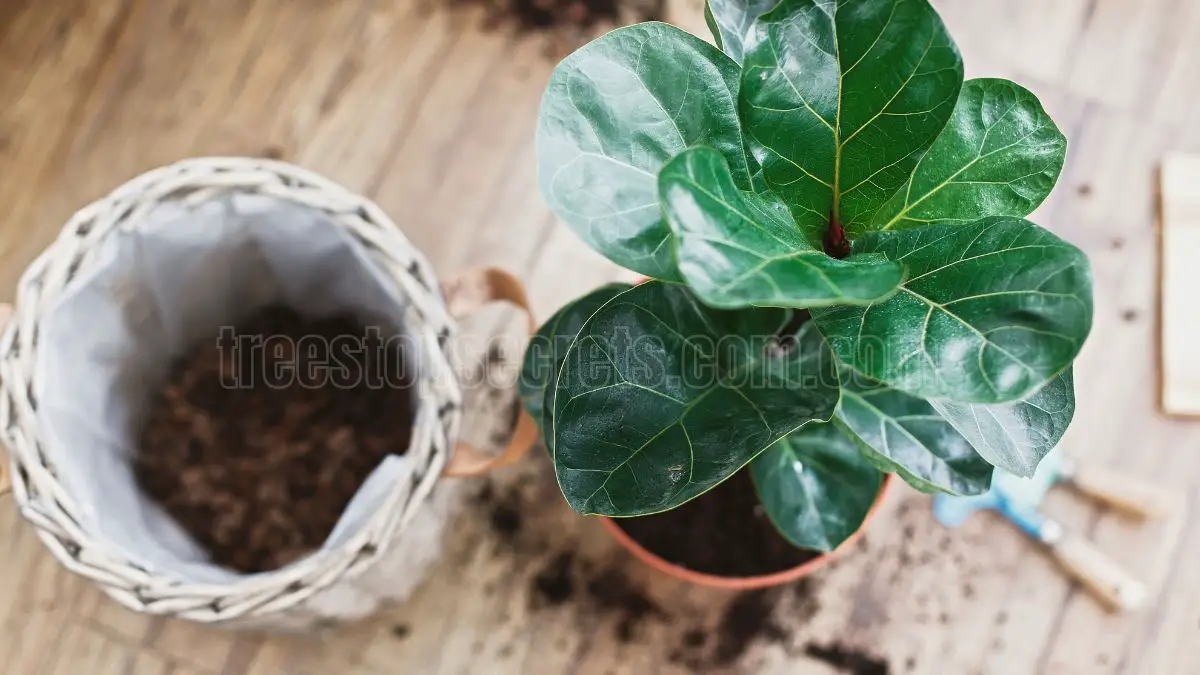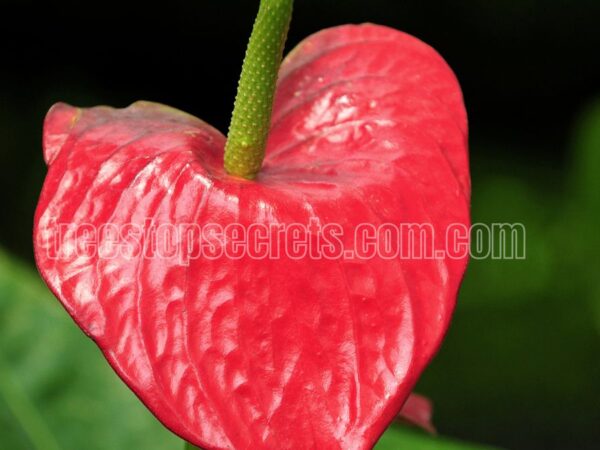A fiddle leaf fig soil mix recipe is the key to getting your fiddle leaf fig to be healthy and happy. A fiddle leaf fig can thrive only with a quality mix of well-draining soil that holds sufficient moisture while still offering excellent drainage and aeration.
The ideal mixture consists of potting soil, perlite, and peat moss for maximum aeration and water retention. These ingredients work together to keep root rot at bay, the most frequent ailment of fiddle leaf figs.
It’s very easy to mix your own soil at home and much more economical, you have control over the quality of the ingredients. So we put together this in-depth guide, complete with a recipe, to help you make your fiddle leaf fig’s ideal soil mix.
You’ll find advice on how to keep it happy and healthy indoors too!
Key Takeaways
- Knowing the exact soil requirements for fiddle leaf figs is essential to ensuring a happy and healthy plant. Proper soil should be moisture-retentive but provide a good level of drainage to avoid root rot.
- The best soil mix for fiddle leaf figs is one that mixes organic materials, like compost, with inorganic materials, like perlite. This perfect balance encourages healthy root growth and increases the health of the whole plant.
- Keeping your soil pH above 6 is important so that your tree can absorb all the nutrients. Test soil pH regularly and make adjustments as needed to keep your fiddle leaf figs healthy.
- By mixing your own soil, you can truly customize to meet the needs of your plant. Feel free to try out various components and percentages to discover what works best for your fiddle leaf figs!
- Keeping an eye on soil conditions will help catch things like yellowing of leaves and shorter-than-normal growth before they become a major problem. Use fertilization methods and seasonal changes to maintain the soil healthy and nutrient-rich.
- You can help with nutrients during repotting by selecting an appropriate pot size and recharging the soil. Follow these best practices to help prevent transplant shock and set your plants up for success once they’ve been repotted.
Understanding Fiddle Leaf Fig Soil Needs
The type of soil mixes you use is one of the most important factors in keeping your fiddle leaf plant looking its best. The perfect fiddle leaf fig soil ignites healthy growth and flourishing leaves, mimicking the conditions of a plant’s natural habitat perfectly!
1. What Makes Ideal Soil for Fiddle Leaf Figs?
A good fiddle leaf fig soil mix will have ingredients such as peat moss, perlite, and pine bark. These qualities are key to preventing root rot and developing a healthy root structure.
Peat moss holds onto some moisture but still lets extra water drain out. Perlite provides extra airflow, and pine bark adds drainage. The key is striking the right balance of organic matter with inorganic materials.
Too much organic matter can lead to water retention issues that rot the roots.
2. Importance of Well-Draining Soil
Proper drainage is essential to avoid problems like root rot and yellowing leaves. Fiddle leaf figs need well-draining soil to establish healthy root systems without the risk of waterlogging.
This drainage will help prevent pests as well because stagnant water can draw in nasty bugs.
3. How Soil pH Affects Plant Health
Keeping the soil pH of your fiddle leaf fig around 6 or above can make a big difference in their health. Soil pH affects nutrient absorption, which in turn impacts the health of the plant.
Soil pH is pretty easy to test with a home kit. If your soil does need some adjustments, it’s as simple as adding amendments such as lime or sulfur.
Crafting Your Own Fiddle Leaf Fig Soil Mix
Crafting your own soil mix allows you to give your fiddle leaf fig the perfect environment, encouraging healthy growth and preventing issues. A custom mix of soil will better suit the needs of these tropical beauties. This mix encourages healthy leaves and avoids problems such as root rot.
Read on for a simple guide to making your homemade soil mix really work.
- Gather essential ingredients: organic matter, drainage materials, and amendments.
- Mix the components in the recommended ratios.
- Make sure to regularly test your soil pH and keep it in the range of 6-7.
- Adjust as needed based on your plant's response.
1. Essential Ingredients for Your Soil Recipe
Peat moss holds moisture without getting soggy and still lets in air, which is key for your fiddle leaf fig’s roots. Perlite improves drainage and aeration, making sure the soil doesn’t hold water. Compost adds microbes and nutrients.
The better quality materials you source, the better the results will be for your plants.
2. Optimal Ratios of Organic and Inorganic Components
A 50/50 mix of organic material and inorganic material works well. When you change these ratios, you either increase or decrease the mix’s ability to retain water and deliver nutrients.
For example, the more perlite you add, the better the drainage will be.
|
Ingredient |
Ratio (%) |
|---|---|
|
Peat Moss |
30 |
|
Perlite |
30 |
|
Compost |
40 |
3. Best Drainage Additives to Prevent Root Rot
For remarkable drainage properties in your ideal fiddle leaf fig potting mix, try incorporating pumice or coarse sand. Grit not only provides better soil stability but also enhances aeration.
4. Incorporating Natural Amendments for Vitality
Materials such as worm castings and compost add diversity to the soil, helping to nourish your fiddle leaf plant with essential nutrients. Keeping a well-rounded nutrient balance will lead to strong, thriving fiddle leaf fig trees.
Maintaining Soil Health for Fiddle Leaf Figs
Soil health is key to a healthy fiddle leaf fig. These premium fiddle leaf fig trees thrive in loose, well-draining soil mixes, which help prevent issues like waterlogging and root rot. Regular monitoring of soil conditions and plant health enables early detection of issues, ensuring your beautiful plant remains robust.
- Ensure the soil is well-draining and aerated.
- Monitor soil moisture levels consistently.
- Adjust fertilization based on growth stages.
- Repot during the growing season to avoid shock.
- Observe for signs of nutrient depletion.
1. Recognizing Signs of Poor Soil Conditions
Some signs of unhealthy soil can be yellow leaves or lack of growth. Test soil water by feeling the top inch or two of soil to see if it is dry. If the soil seems overly moist or compact, improve the mix with coarser materials such as bark chips.
This will help with drainage and have your garden happy and healthy. Troubleshooting these problems right away will stop them from worsening.
2. Fertilization Strategies for Healthy Growth
Proper fertilization replenishes nutrients. Apply a fertilizer with quick-release ingredients to deliver immediate nutrition, followed by slow-release fertilizer to fuel continued growth and vitality.
Fertilize during the Spring and Summer months, the fiddle leaf fig’s peak growth period.
3. Seasonal Adjustments to Soil Composition
Seasonal changes impact moisture and nutrient needs. During the warmer months, you can mix in some vermiculite to help retain moisture while avoiding sogginess.
During the plant’s seasonal growth stages, pay close attention to environmental conditions to adjust soil composition accordingly and maintain long-term soil health.
Repotting Your Fiddle Leaf Fig with Confidence
Repotting a fiddle leaf fig requires some preparation, but with the right pot and high quality potting mix, your beautiful plant will flourish! Knowledge is power; learning how to repot your fiddle leaf plant will make the process less daunting and more successful.
- Gather your materials: A bag of soil mix, a new container, and fresh tools.
- Choose the right time: Make sure to repot in late spring or early summer.
- Prepare the new pot: Good drainage is key. Make sure you use pots with holes.
- Gently remove the plant: Loosen the root ball carefully.
- Refresh the soil: Take away as much old soil as you can and replace it with new soil.
- Repot and water: Put the plant in its new pot and give it a good drink.
1. Best Practices for Repotting to Minimize Shock
Reducing transplant shock impacts how quickly your fiddle leaf fig will recover from repotting. Best Practices for Repotting to Minimize Shock Timing is important. Repot during active growth periods, usually in spring.
Be gentle as you untangle the roots to avoid breakage, but if you find many long roots, feel free to trim them back to encourage new growth.
2. Steps to Refresh Soil During Repotting
Begin by carefully clearing away the old soil, as this keeps disease and nutrient depletion at bay. Start by loosening the soil around the roots.
Remove the old soil by gently shaking the plant and replenishing it with a mix that promotes drainage. Try mixing potting soil, perlite, and peat moss together.
3. Choosing the Right Container Size
Choosing the right size container is critical to the health of your fiddle’s roots. A container that is too small will limit growth, and a container that is too big can make it difficult to properly water your plant and result in overwatering.
Select a pot that’s one to two inches wider across than your current pot. This allows your plant to grow and prevents the roots from being waterlogged.
Comparing Homemade Mixes with Commercial Options
When deciding between homemade potting mixes and commercial options for the ideal fiddle leaf fig, it’s essential to understand their respective features and benefits, as both influence healthy fiddle leaf fig growth.
1. Pros and Cons of DIY Soil vs. Store-Bought Mixes
Customizing potting compounds such as peat moss, perlite, and orchid bark expressly to address your fiddle leaf figs’ needs can be beneficial. This reduces compaction, improving drainage and aeration, which results in healthier roots.
On the downside, making your own mix can be time intensive, and you need a bit of gardening expertise to achieve the proper ratio of ingredients. Store-bought mixes provide convenience and consistency, perfect for the plant parent on the go.
However, they may not have ingredients that cater to the needs of fiddle leaf figs. That might lead to inadequate growth of your plants.
2. User Experiences and Field Studies Insights
User experiences and field studies show uneven results from soil mix to soil mix. Many gardeners have reported a good homemade mix recipe, resulting in healthier, more vigorous plants.
Field studies back this up, showing that customized soil tactics result in vigorous, happy fiddle leaf figs. User experiences are skewed toward high-quality commercial mixes, partly due to their convenience.
Distributing these findings throughout the gardening community helps build a collaborative environment where everyone can learn from each other’s successes and failures.
Troubleshooting Common Soil Issues
Soil issues for fiddle leaf figs can be a common problem for many fiddle leaf fig owners. Knowing how to identify and treat these issues, such as choosing the right potting mix or ensuring a nutrient balance, is key to keeping your beautiful plants healthy and happy.
- Mold Growth: Look for white or fuzzy spots on the soil surface. This is a sign of too much water most of the time.
- Compacted Soil: Soil compaction prevents roots from growing and water from draining.
- Nutrient Deficiency: If leaves are turning yellow, it could mean your soil is missing some key nutrients.
1. Identifying Mold and Overly Moist Conditions
Identification Mold growth is often first suspected due to smell, followed by visible fungal growth. Too much moisture is usually a consequence of overwatering or lack of drainage.
To increase air circulation, put your fiddle leaf fig in a room with strong airflow. In addition to this, always select pots that have drainage holes in the bottom for excess water to escape through.
2. Solutions for Addressing Soil Problems
Water less often, but use more water each time. Let the top inch of soil dry out between waterings.
Monitor your soil moisture regularly to prevent problems from developing, and if possible, use a moisture meter to ensure accurate readings.
3. Refreshing Soil for Long-Term Health
Remove Your Fiddle Leaf Fig from Its Pot Begin by removing your fiddle leaf fig from its current pot. Remove the old soil and replace with new soil mix to perk up the houseplant.
Completing this procedure every 12-18 months will replenish nutrient deposits. It provides a great tilth, or crumb structure, for the soil, critical for strong roots.
Continuous learning about your plant's needs fosters better care practices.
Conclusion
Making sure you have the appropriate soil mix for your fiddle leaf fig will lay the foundation for a healthy plant. Learning about what it prefers, and making a proper mix with the right components ensures that your plant remains happy and healthy. Simple tasks, such as repotting and checking for bugs, go a long way to help you identify problems before they worsen. Homemade mixes frequently out work their store-bought compatriots, allowing you the power to control the quality.
Playing around with your own mix is the best way to figure out what works best in your own environment. Experiment, learn, and see how your fiddle leaf fig thrives under your care. Post your plant parent success stories and advice to guide other people on their journeys to become successful plant caretakers. Happy planting from all of us at Garden Junction!
Frequently Asked Questions
What type of soil do fiddle leaf figs need?
Fiddle leaf figs thrive in a well-draining soil mix that retains moisture, making a combination of high quality potting mix, perlite, and peat moss ideal for their health and promoting healthy fiddle leaf fig growth.
Can I use regular potting soil for my fiddle leaf fig?
If you want to use regular potting soil for your fiddle leaf plant, you can, but we recommend mixing it with perlite or coarse sand to create the perfect fiddle leaf fig soil with excellent drainage.
How often should I repot my fiddle leaf fig?
How often should I repot my fiddle leaf fig trees? This is beneficial because it refreshes the quality of the high quality potting mix and allows for more root space.
What are the signs of unhealthy soil for fiddle leaf figs?
Signs of unhealthy soil for fiddle leaf figs include yellowing leaves, stunted growth, or root rot. If you notice these signs, test the drainage of the high quality potting mix and plan to repot your fiddle leaf plant.
Is it necessary to fertilize fiddle leaf figs?
Good news, growth junkies—if you want your fiddle leaf fig trees to thrive, fertilizing in spring and summer will speed healthy houseplants' growth. Use a balanced fertilizer every 4-6 weeks for optimal growth.
Can I make a homemade soil mix for my fiddle leaf fig?
A combination of high quality potting mix, perlite, and peat moss will do the trick for your fiddle leaf plant. You can always adjust the ratios, depending on what your plant needs.
How can I maintain soil health for my fiddle leaf fig?
Moisture test regularly, don’t overwater, and top-dress with high quality potting mix. This prevents any breakdown of nutrients from getting out of balance, ensuring all-around healthy fiddle leaf fig growth.
Image Source: Paid image from CANVA




